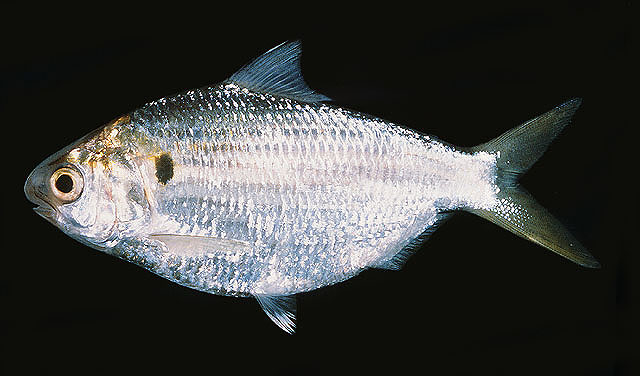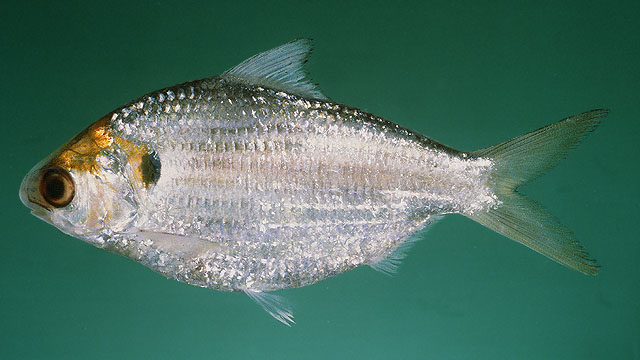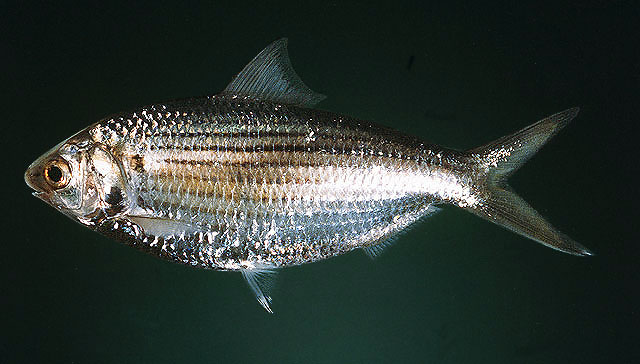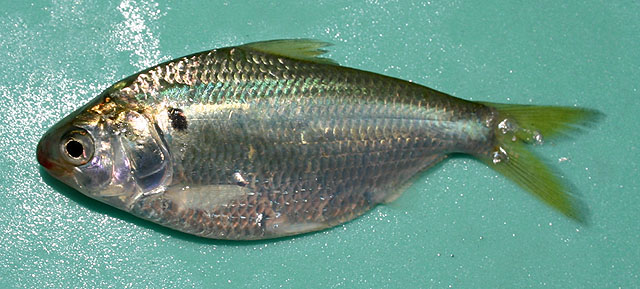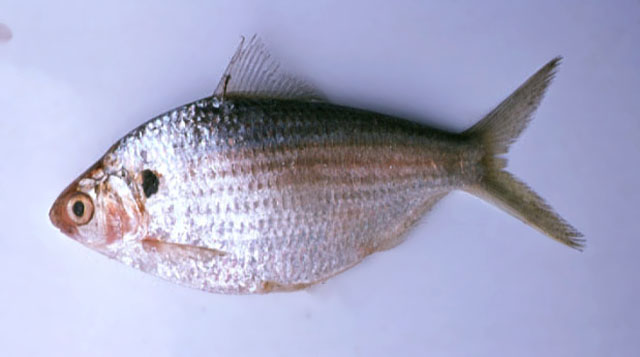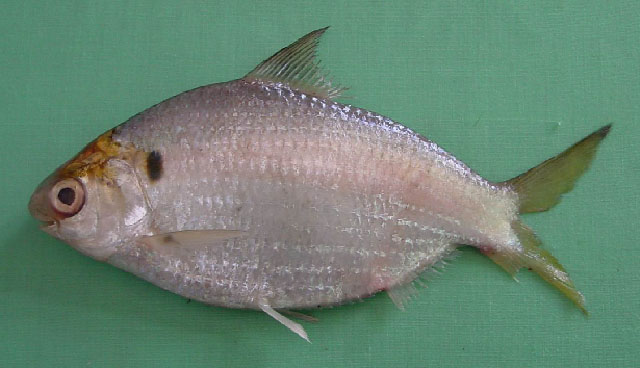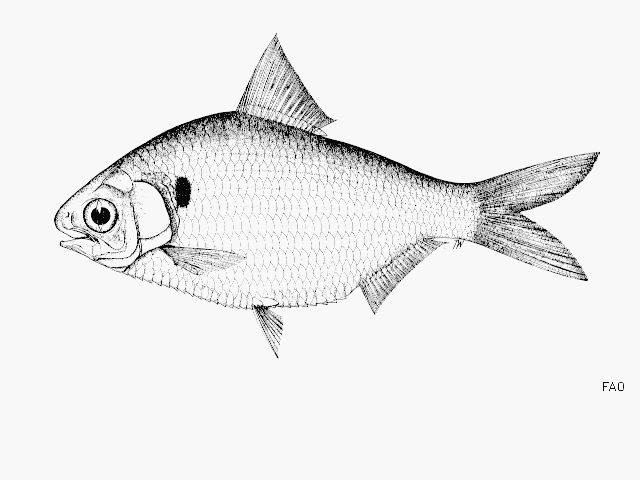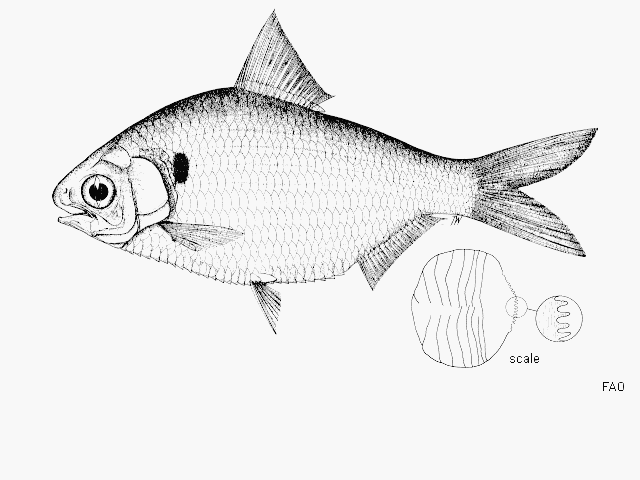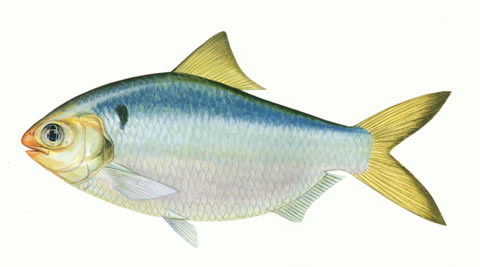Anodontostoma
chacunda
(Hamilton,
1822)
Chacunda gizzard shad
View all media / Upload your photos and videos
Expand all
Classification / Names
Teleostei (teleosts) > Clupeiformes (Herrings) >
Dorosomatidae (Gizzard shads and sardinellas)
Etymology: Anodontostoma: Greek, ana = up + Greek, odous = teeth + Greek, stoma = mouth (Ref. 45335).
More on author:
Hamilton.
Environment / milieu / depth range / climate zone / distribution range
Distribution
Indo-West Pacific: Persian Gulf to coasts of India and Andaman Sea, to Gulf of Thailand, Indonesia, Viet Nam, and Philippines, south to northern Australia, the Caroline Islands and New Caledonia.
Maps

Anodontostoma chacunda / Native range
AquaMaps Data sources:
GBIF
OBIS
This map was computer-generated and has not yet been reviewed.

Anodontostoma chacunda / Suitable habitat
AquaMaps Data sources:
GBIF
OBIS
This map was computer-generated and has not yet been reviewed.

Anodontostoma chacunda / Point map
AquaMaps Data sources:
GBIF
OBIS
This map was computer-generated and has not yet been reviewed.

Anodontostoma chacunda / Year 2050
AquaMaps Data sources:
GBIF
OBIS
This map was computer-generated and has not yet been reviewed.
Length at first maturity / Size / Weight / Age
Short description
Dorsal spines (total): 0; Anal spines: 0; Anal soft rays: 17 - 25. Body depth increasing with size of fish, 40 to 70 % standard length in fishes over 10 cm. Second supra-maxilla a mere splint. Longest gill rakers on lower part of arch less than corresponding gill filaments. Hind edges of scales toothed, the teeth thinner than the gaps between them; a median series of pre-dorsal scales. A large black spot behind gill opening.
Biology
Pelagic inshore (Ref. 68964). Usually marine coastal, but ascends rivers to the upper tidal zone (Ref. 12693). Occurs inshore and also in estuaries. Feeds on diatoms, radiolarians, mollusks, copepods, and crustaceans (in that order of importance, at least in the Godavari estuary). Breeds from November to February, mainly in the later part (Godavari estuary). Marketed fresh, frozen, dried, dried-salted or boiled. Made into fish balls.
Main reference
Whitehead, P.J.P. 1985 FAO Species Catalogue. Vol. 7. Clupeoid fishes of the world (suborder Clupeoidei). An annotated and illustrated catalogue of the herrings, sardines, pilchards, sprats, shads, anchovies and wolf-herrings. FAO Fish. Synop. 125(7/1):1-303. Rome: FAO. (Ref. 188)
IUCN Red List Status (Ref. 125652)
Least Concern (LC); date assessed: March 06 2017
CITES (Ref. 131153)
Not Evaluated
CMS (Ref. 116361)
Not Evaluated
Threat to humans
Harmless
More information
- Countries
- FAO areas
- Ecosystems
- Occurrences
- Introductions
- Stocks
- Ecology
- Diet
- Food items
- Food consumption
- Ration
- Common names
- Synonyms
- Metabolism
- Predators
- Ecotoxicology
- Reproduction
- Maturity
- Spawning
- Spawning aggregation
- Fecundity
- Eggs
- Egg development
- Age/Size
- Growth
- Length-weight
- Length-length
- Length-frequencies
- Morphometrics
- Morphology
- Larvae
- Larval dynamics
- Recruitment
- Abundance
- References
- Aquaculture
- Aquaculture profile
- Strains
- Genetics
- Allele frequencies
- Heritability
- Diseases
- Processing
- Mass conversion
- Vision
- Pictures
- Stamps, Coins Misc.
- Sounds
- Ciguatera
- Speed
- Swim. type
- Gill area
- Otoliths
- Brains
Estimates based on models
Preferred temperature (Ref. 123201): 26.5 - 29.1, mean 28.3 °C (based on 1250 cells).
Phylogenetic diversity index (Ref. 82804): PD50 = 0.625 [Uniqueness, from 0.5 = low to 2.0 = high].
Bayesian length-weight: a=0.00891 (0.00780 - 0.01019), b=3.05 (3.01 - 3.09), in cm total length, based on LWR estimates for this species (Ref. 93245).
Trophic level (Ref. 69278): 2.8 ±0.3 se; Based on food items.
Generation time: 1.3 ( na - na) years. Estimated as median ln(3)/K based on 2 growth studies.
Resilience (Ref. 120179): High, minimum population doubling time less than 15 months (K=0.9-1.3).
Prior r = 1.19, 95% CL = 0.79 - 1.79, Based on 4 data-limited stock assessments.
Fishing vulnerability (Ref. 59153): Low vulnerability (14 of 100).
Climate vulnerability (Ref. 125649): Moderate to high vulnerability (51 of 100).
Price category (Ref. 80766): Low; Reliable: based on ex-vessel price for this species.
Nutrients (Ref. 124155): Calcium = 282 [162, 519] mg/100g; Iron = 2.3 [1.3, 3.8] mg/100g; Protein = 19 [18, 20] %; Omega3 = 0.416 [0.233, 0.743] g/100g; Selenium = 53.1 [26.1, 110.1] μg/100g; VitaminA = 12.1 [4.9, 28.2] μg/100g; Zinc = 2.17 [1.53, 3.17] mg/100g (wet weight);

